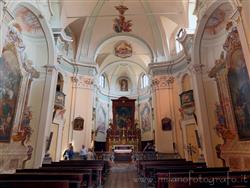|
Oggiono (Lecco, Italy): Church of San Lorenzo
|
|
|
Show an other place around Milan worth a visit: |
 The church of San Lorenzo is a baroque-style church located on the outskirts of the town, near the cemetery. The church of San Lorenzo is a baroque-style church located on the outskirts of the town, near the cemetery.
HISTORY
The church has ancient origins. The first version was built in the thirteenth century. After a period of abandonment it was first modernized at the turn of the sixteenth and seventeenth centuries and changed of dedication, with the Blessed Virgin with the deposed Christ as a new dedication.
Become the seat of the Confraternity of the Immaculate Conception, in the first half of the eighteenth century it was decided to replace it with a new larger building, the one currently visible, in Baroque style. The works started in 1745 and were completed in 1751.
In later times the large portico was added, above which is the caretaker's apartment.
STRUCTURE
The façade, divided vertically by four large pilasters, is dominated by the large portico, which occupies the entire width of the building and which on the front side creates a sort of large serliana in serizzo stone (apart from the central arch).
At the center of the façade there is a fresco by Pasquale Agudio from 1914 depicting Saint Lawrence with the grill on which he was martyred, a book and an angel who hands him the palm of martyrdom. Note the purgatory souls rescued by the angels below.
At the top of both the portico and the façade there are baroque pediments with rounded lines.
The actual body of the church is rectangular. However, the very rounded edges make it seem almost elliptical.
The bell tower is fused with the body of the church, on the left side, at the base of the apse, and is barely higher than the rest of the building.
The interior, in late Lombard Baroque style, is very bright thanks to the presence of numerous windows, although placed in the upper part of the building.
The impression is that of being in an elliptical space. In reality the central body is, as said, rectangular. However, the very rounded edges and the presence on each side of a shallow chapel with rounded side walls that do not form any edge with the back wall effectively mask the rectangular base structure. The roof has a rectangular dome with lunettes and with a fresco depicting the Assumption with St. Lawrence and St. John the Baptist inside a baroque mistiline stucco frame in the center.
Also the apse, deep and with a semicircular bottom, contributes to the feeling of being in an elliptical space.
Another peculiarity of the interior of the church is represented by the presence of six exedras, that is small, slightly protruding pulpits, four in correspondence with the corners of the central body and two in the apse. Only some of them are really accessible, the others are just decorative.
Also noteworthy are the elaborate vegetal-themed capitals of the broad and flat pilasters that mark the vertical surfaces, also in the apse.
The church has two lateral chapels, not clearly separated from the rest of the interior, but consisting of sort of large wraparound niches.
Each of these houses a large canvas on the back wall framed by an trompe l'oeil retable placed above an altar, it also trompe l'oeil. The canvas on the left depicts "Saint Anne with Mary as a child", the one on the right Saint Philip Neri, the Virgin and children". Note, in the chapels, the trompe l'oeil window depicted on the ceiling.
The apse is separated from the nave by a marble balustrade. The high altar and the large retable above it are both made of wood. The second acts as a frame for a large mannerist painting of 1609 by Paolo Camillo Landriani, known as Duchino, depicting a Virgin with the Dead Christ between San Rocco and San Sebastiano. Below, in the foreground, a Saint Lorenz can be seen, represented with the features of Cardinal Federico Borromeo, and on the right Saint Vincent Martyr, represented with the features of San Carlo.
The altar is also equipped with a wooden frontal in which four caryatids are carved.
The valuable carved wooden tabernacle is from the seventeenth century.
The back of the altar is also interesting. Curious is the presence, as structural elements, of two unworked tree trunks. A confessional from the seventeenth century is placed against the back of the altar, flanked by two plaster statues of the eighteenth century.
The lower part of the apse walls are occupied by the seats of the seventeenth century wooden choir.
Above the choir there are, inside rich Baroque stucco cornices, frescoes depicting the Annunciation, the Assumption and the Visitation. The central fresco is surmounted by a painting that reproposes St. Lawrence with a grill, on a false window. On the vault there is the Eternal Father (creation of the world).
Finally, on the great arch there is a Crucifix depicted with a particularly realistic trompe l'oeil effect.
Categories: Places of historical value of artistic value
Via Giuseppe Parini, 33, 23848 Oggiono LC |
Further pictures of Church of San Lorenzo in the section Photography |